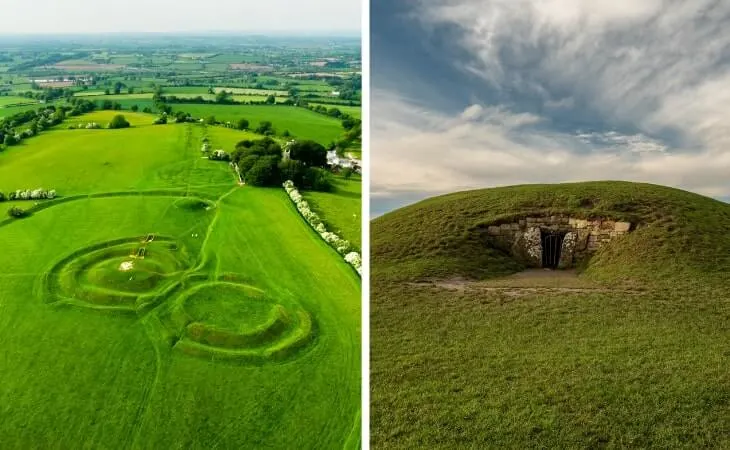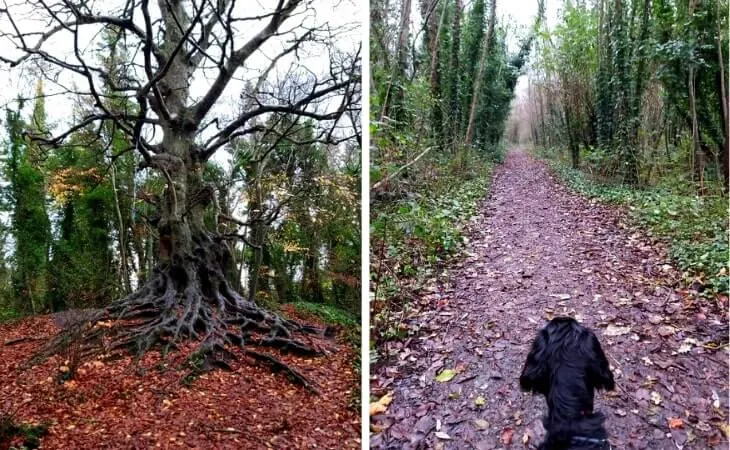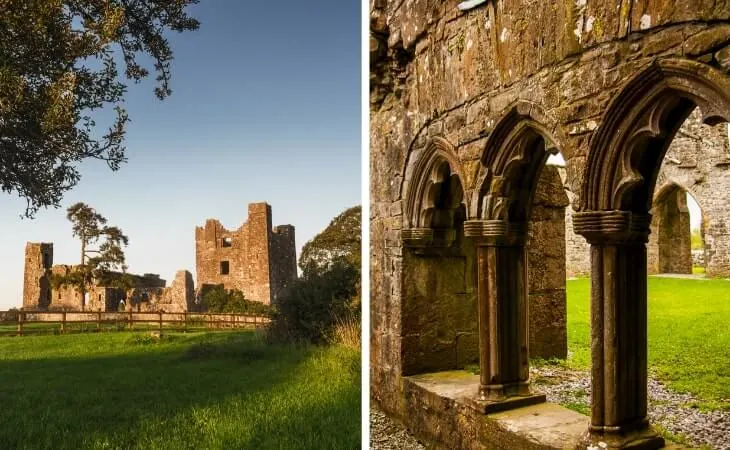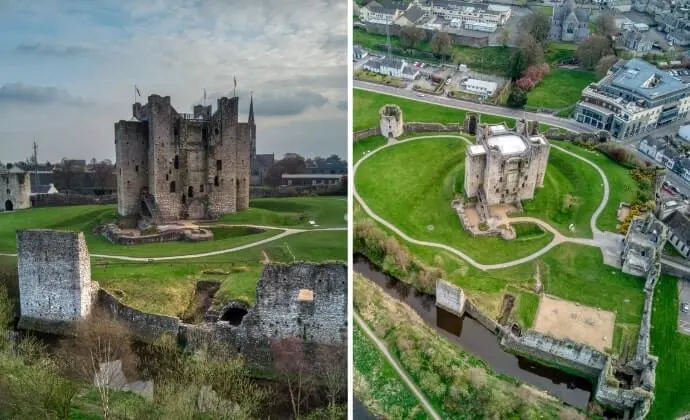The ancient Hill of Tara is one of the more popular places to visit in Meath for good reason.
Steeped in both Irish mythology and history, the oldest visible monument at the Hill of Tara dates back to 3,200 BC.
The site itself, which is part of the Boyne Valley Drive, is free to visit, however, there’s a well-reviewed paid tour that’ll immerse you in the areas past.
In the guide below, you’ll find info on everything from the history of the area to the popular Tara Hill walk. Dive on in!
Some quick need-to-knows about The Hill Of Tara

Photos via Shutterstock
Although a visit to the ancient Hill of Tara is fairly straightforward, there are a few need-to-knows that’ll make your visit that bit more enjoyable.
1. Location
The Hill of Tara can be found in Castleboy in County Meath. It’s a 20-minute drive from Trim, a 25-minute drive from Slane and a 30-minute drive from Brú na Bóinne.
2. Opening hours + visitor centre
The Hill of Tara can be accessed 24 hours a day, all year round. As you enter the site, you will find a little 19th-century church where the Hill of Tara visitor centre is situated. The centre is open from 10.00 am to 6.00 pm (hours can change – see their Facebook page for latest info).
3. The hill is free (you pay for the tour)
Entrance to the Hill of Tara is completely free. Free guided tours are scheduled every day (when you arrive just ask at reception for the next available one). The guided tour is definitely worth doing if the online reviews are anything to go by.
4. You need cash
Bear in mind that the Hill of Tara visitor centre doesn’t accept credit cards. So, make sure to bring some cash with you!
5. Mythology
The Hill of Tara was the residence of the High Kings of Ireland who, according to legend, ruled over the whole of Ireland.
6. St. Patrick
It’s said that, in 433, St.Patrick lit the Paschal fire (a fire lit at the beginning of Easter to mark the light of Christ entering the world) on the Hill of Slane in an act of defiance against the King of Tara, who was a Pagan.
Hill of Tara history
One of the reasons that tourists flock to the Hill of Tara is due to the areas rich history, which stems from the Neolithic Period.
Below, you’ll find a speedy history of the area, to give you a sense of what to expect if you take the tour.
Neolithic, Early Bronze Age and Iron Age
The oldest visible monument on the Hill of Tara is Dumha na nGiall, meaning ‘The Mound of the Hostages’, an ancient Neolithic passage tomb dating back to 3,200 BC.
This site served as the communal tomb of a little community living in the area and almost 300 bodies were discovered buried here. However, this site became truly important during the Iron Age and the Early Christian Period.
During the early Bronze Age, a timber circle was built on top of the Hill of Tara. The structure was 820 feet (250 metres) metres in diameter and was situated next to six small burial mounds. During the Iron Age, several enclosures were also built on the site.
The Battle of Tara
The Hill of Tara was the setting for a great battle, aptly named the ‘Battle of Tara’ which involved the Gaelic Irish, led by Máel Sechnaill (a High King) and the Norse Vikings. As records for this time are slim, it’s difficult to ascertain what the battle was over.
However, some believe that the battle stems from when the Norse Viking King of Dublin kidnapped the King of Leinster. The battle was fought and the Gaelic Irish were victorious.
After his victory, Máel Sechnaill led his troops to Dublin and seized valuables and reclaimed land. The capital, to an extent, remained under the rule of Máel Sechnaill for many years after.
Samhain and Saint Brigid’s Day
Like many ancient sites in Meath (Newgrange and Dowth), the Hill of Tara has a connection with a specific time of the year. It’s during Samhain (a Gaelic festival that signals the end of the harvest season) and Saint Brigid’s Day that the magic happens.
On November 1st (Samhain), the Mound of the Hostages (Tara’s oldest visible monument) is aligned with sunrise, and the rising rays illuminate the chamber within. The same happens on February 1st (Saint Brigid’s Day).
More mythology
According to legend, Conn Cétchathach, one of Ireland’s High Kings, stepped on Lia Fáil, the famous Stone of Destiny, which is said to have been placed there by the Tuatha Dé Danann (a supernatural race).
This stone was said to cry out every time a High King would step on it. Right after Conn put his feet on top of it, the stone started to let out multiple cries, each of which represented one of Conn’s descendants who would grow to become High King of Ireland.
Things to see and do at The Hill Of Tara

Photos via Shutterstock
There’s plenty to see in and around the Hill of Tara, once you know what to look out for. Here’s a handful of things to do and what to keep an eye out for.
1. Ancient monuments
The Hill of Tara is home to more than 30 visible ancient monuments and it’s estimated that many more lie underneath its soil. For instance, a huge temple measuring 557 feet (170 metres) has been recently detected beneath this site using modern non-intrusive archaeological techniques.
Some of the other monuments found here include Bronze Age barrows, a large ringfort of 230 feet (70 metres) in diameter and Iron Age enclosures.
2. Iron Age enclosures
During the Iron Age, several enclosures were built on the Hill of Tara. On the top of the hill, you will find the biggest one, known as Ráth na Ríogh, meaning ‘The Enclosure of the Kings’.
This massive structure measures 3,300 feet (1 kilometre) in circumference, 1,043 feet (318 metres) from north to south and 866 feet (264 metres) from west to east.
The enclosure also had an outer bank and an inner ditch in which human burials, along with animals bones, were found.
3. The Rath of the Synods
The Rath of the Synods is an unusual example of a ringfort, and it has four banks and ditches. This site can be found north of the Mound of the Hostages. Its name is derived from an important medieval church synod that took place here.
There are only a few other similar sites in the whole of Ireland and they are thought to represent royalty and importance. Ancient artefacts dating back to the 1st and 3rd centuries were also found here.
This site became known in 1898 and 1901 when a group of British Israelites decided to start excavations here in the hope to find ancient artefacts.
4. The church
As you enter the Hill of Tara, you will find an old church dating back to 1822. In the past, two other churches were built on this site.
The first one, which dated back to the 13th century, was later succeeded by a bigger structure. Part of the outer walls of this second church can still be seen from the churchyard.
The present church was deconsecrated in 1991 and since then it has been home to the Hill of Tara Visitor Centre.
5. The guided tour
If you decide to visit the Hill of Tara, make sure to do so when the visitor centre is open. Here you will be able to buy a ticket for the guided tour which will give you detailed information about the history and mythology behind this place.
According to reviews, there are not too many interpretative panels on the site, so unless you book a guided tour, it’ll be very difficult to learn everything there’s to know about this ancient place.
6. The Hill of Tara walk
The Hill of Tara walk is a roughly a 25-35-minute walk that starts at the main car park and that takes you up past the various sites at Tara before reaching The Lia Fáil, AKA the ‘Stone of Destiny’.
This is a pretty handy walk but keep in mind that the area is exposed, so it can get pretty cold and windy.
Things to do near the Hill Of Tara
One of the beauties of the Hill Of Tara is that it’s a short spin away from many of the best places to visit in Meath.
Below, you’ll find a handful of things to see and do a stone’s throw from Tara (plus places to eat and where to grab a post-adventure pint!).
1. Balrath Woods (10-minute drive)

Photos courtesy of Niall Quinn
Balrath Woods is one of my favourite walks in Meath. It’s a fairly short stroll that takes around 30 minutes to complete. just keep in mind that it gets very muddy here at times.
2. Bective Abbey (10-minute drive)

Photos via Shutterstock
Bective Abbey was the second Cistercian monastery to be built in Ireland. It was founded in 1147, however, most of what is visible nowadays dates back to the 13th and 15th centuries.
3. Trim Castle (20-minute drive)

Photos via Shutterstock
Trim Castle is the biggest Anglo-Norman castle in Ireland! There’s plenty of things to do in Trim while you’re there and there’s several excellent restaurants in Trim if you fancy a bite-to-eat.
FAQs about the Tara hills
We’ve had a lot of questions over the years asking about everything from ‘What happened on the Hill of Tara?’ to ‘Can you go inside the Hill of Tara?’.
In the section below, we’ve popped in the most FAQs that we’ve received. If you have a question that we haven’t tackled, ask away in the comments section below.
Is the Hill of Tara worth visiting?
Yes! The Hill of Tara is home to several ancient sites and there’s some gorgeous views out over the surrounding countryside. The tour is also well worth doing.
What is there to see at the Hill of Tara?
The Hill of Tara is home to more than 30 visible ancient monuments that you can have a nosey at. You can also take a guided tour, that’ll immerse you in its past.
Do you have to pay into Tara?
No. You can visit the site for free, however, you’ll have to pay if you want to do the guided tour.

Niall O'Corraigh
Friday 24th of November 2023
Go raibh maith agat - thank you! Very informative AND definitely useful. Slainte agus tainte!